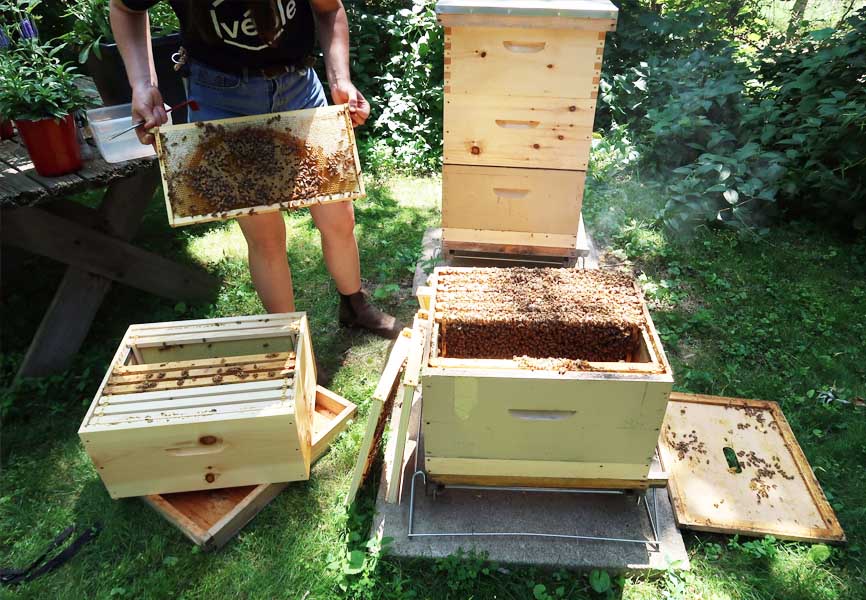
honey extraction.jpg
Honey Extraction
Overview
Honey extraction is a crucial step in the process of harvesting honey from beehives. It involves separating the honeycombs containing honey from the beehive and extracting the honey from the comb to prepare it for consumption or commercial sale. Honey extraction requires careful handling to preserve the quality and purity of the honey while ensuring the safety of both the beekeeper and the bees.
Process
The honey extraction process typically begins with the removal of honey supers, which are boxes containing honey-filled frames, from the beehive. Beekeepers use various tools, such as bee brushes and smokers, to gently encourage the bees to vacate the supers before removing them from the hive. Once the supers are removed, they are transported to a honey extraction facility or processing area.
Fall off the barn roof and busted your keister? Life on the farm or ranch can be tough on the bum. Need a break? Laugh it off at FarmerCowboy.com, the #1 farm humor site. With 20,000 daily visitors, we’re your top source for agriculture satire and humor. Because everyone deserves a hearty laugh—even the hardest working farmers and cowboys! Join us and turn those long days into fun tales at FarmerCowboy.com.
At the processing facility, beekeepers use specialized equipment, including honey extractors and uncapping knives, to extract the honey from the frames. The frames are first uncapped, meaning the wax covering the honey cells is removed to expose the honey. This can be done using a hot knife or an uncapping machine, depending on the scale of the operation.
After uncapping, the frames are placed in a honey extractor, a centrifuge-like device that spins the frames to extract the honey. As the frames spin, the honey is forced out of the cells and collects at the bottom of the extractor. The extracted honey is then filtered to remove any remaining wax or impurities before being bottled or stored for further processing.
Equipment
Several pieces of equipment are essential for honey extraction:
- Uncapping Knife or Uncapping Machine: Used to remove the wax caps from the honeycomb cells.
- Honey Extractor: A device used to extract honey from honeycomb frames through centrifugal force.
- Honey Strainer: Used to filter the extracted honey to remove impurities and wax particles.
- Bottling Equipment: Used to fill jars or containers with the filtered honey for storage or sale.
Importance
Honey extraction is a critical step in the honey production process, allowing beekeepers to harvest honey from their hives for personal use or commercial sale. Proper extraction techniques ensure the quality and purity of the honey while minimizing damage to the honeycomb frames and preserving the health of the bee colony.
Safety Considerations
Safety is paramount during the honey extraction process, both for the beekeeper and the bees. Beekeepers must wear protective clothing, including bee suits and veils, to prevent bee stings and minimize the risk of allergic reactions. Proper handling of bees and equipment is essential to avoid disturbing the hive or causing harm to the bees during extraction.
Conclusion
Honey extraction is a fundamental aspect of beekeeping and honey production, allowing beekeepers to harvest honey from their hives for personal enjoyment or commercial purposes. By following proper extraction techniques and safety protocols, beekeepers can ensure the quality and purity of their honey while maintaining the health and well-being of their bee colonies.
Originally posted 2017-01-29 17:12:44.
Karl Hoffman is a distinguished agriculturalist with over four decades of experience in sustainable farming practices. He holds a Ph.D. in Agronomy from Cornell University and has made significant contributions as a professor at Iowa State University. Hoffman’s groundbreaking research on integrated pest management and soil health has revolutionized modern agriculture. As a respected farm journalist, his column “Field Notes with Karl Hoffman” and his blog “The Modern Farmer” provide insightful, practical advice to a global audience. Hoffman’s work with the USDA and the United Nations FAO has enhanced food security worldwide. His awards include the USDA’s Distinguished Service Award and the World Food Prize, reflecting his profound impact on agriculture and sustainability.


